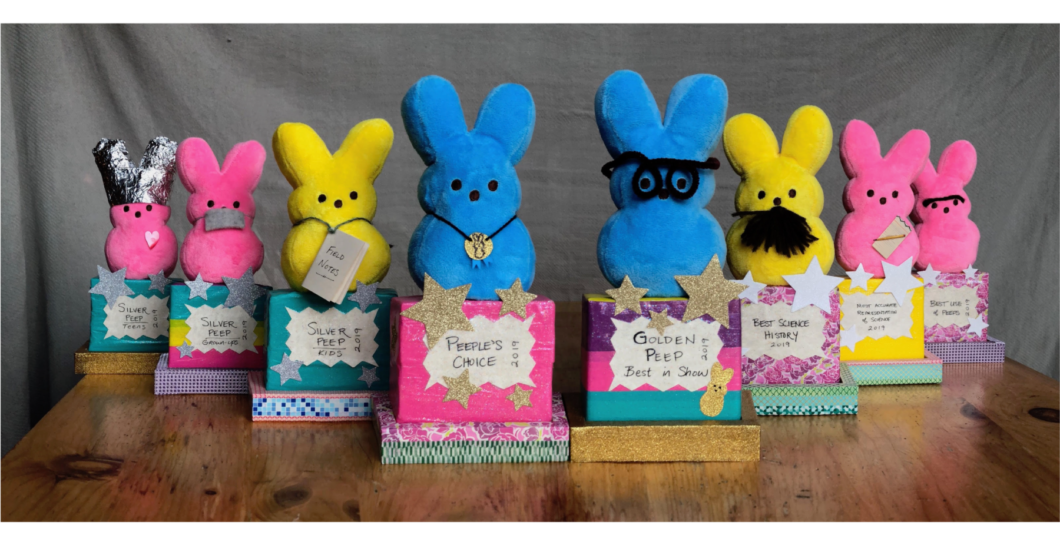The winners of The World’s Finest (and Only … As Far as We Know) Science-Themed Peeps Diorama Contest have been chosen, and we’re happy to announce the crème(-filled eggs) de la crème(-filled eggs)!
Our panel of six judges found themselves in a situation as sticky as the crafting material itself—choosing winners from among the 50 entries, each of which used Peeps to create a science-themed tableau. After hours of deliberations, they reported:
“This was an extremely difficult decision-making process, as so many of these projects show great creativity, informative science, thoughtful details, and crafting skill. There was something to delight us in far more projects than we were able to recognize through prizes and certificates. We hope that everyone who entered knows how much we enjoyed seeing their dioramas, and we hope that they all keep working away—at science, and at Peep dioramas.”
Without further ado, here are the winners and honorable mentions, along with comments from the judges and crafters themselves.
Golden Peep (Best in Show):
Hidden Peeps

Hidden Peeps is an artistic rendering of the Black women who made essential contributions to the US scientific space program at NASA. The right side of the diorama depicts the women, known as computers, whose work enabled US spaceflights but went largely unsung. The details include Dorothy Vaughan programming an early computer, Katherine Johnson and Mary Jackson writing their official technical reports, other women doing math on the chalkboard, calculating trajectories, verifying fight patterns. Be sure to check out the ‘colored’ bathroom sign (NASA’s facilities in Virginia were segregated), the Mary Jackson quote, the women’s glasses, typewriter, pencils, coffee mugs and family peeps photo. The other side of the diorama depicts the men receiving attention and accolades for the space program complete with astronaut John Glenn in the rocket, military band, NBC photographer, and medals. Check out the NASA logo and the Neil Armstrong-inspired banner, “One small hop for Peeps….” (Ella, age 14, led the project; she designed the diorama and did most of the Peeps work – painting male peeps and band, dressing women peeps; made pencils, typewriter, family photo, mugs, desks, camera, staged diorama. Sam, age 17, created NASA Peeps logo.) [See the full entry at TON‘s Peeps gallery.] Ella Theoharis, Jeanne Theoharis, George Theoharis, Sam Theoharis
What the judges said: We appreciated that the diorama addressed a social topic as well as the science, and we admired the use of multi-colored Peeps. Rather than simply recreating a scene, the diorama expanded on the themes of the movie. We love the attention to detail, including costumes, items like mugs, notes, and blackboards; and the background with a NASA logo. Also, everything was nicely made.
Crafters: Ella Theoharis (14) and Sam Theoharis (17), Fayetteville, New York; Jeanne Theoharis, Professor at Brooklyn College-CUNY, Brooklyn, New York; and George Theoharis, Professor at Syracuse University, Fayetteville, New York.
What inspired you to make this diorama?
Each year for about four years, we make a Peep diorama. We look for a project that mixes a political message with a contemporary issue. We particularly look for ideas where we can do a variety of details in the diorama. With The Open Notebook call to have a science theme, Hidden Figures (Hidden Peeps) was perfect. We could create a feminist celebration of the unsung black women who made such important contributions to the scientific space program with all kinds of Peep details.
What did you find the most fun about crafting with Peeps? Most challenging?
We love the details! We love making clothes and outfits and putting in fun little details, like Peeps puns or pencils, news cameras, etc. We love making a Photoshopped image—taking something real (like the NASA logo) and adding a Peep; we like using realistic black-and-white backgrounds to make the Peeps and details pop.
Most challenging: Sometimes it is tricky to get things to stick to the Peeps with their sugar coating.
What advice do you have for others who want to make Peep dioramas?
We have found making clothes to be really fun. We spray-paint the entire Peeps when we want different skin tones. We like a mix of painting clothes and making clothes from fabric, etc.
Is there anything else people should know about you or your diorama?
We have been making Peep dioramas for about four years. Ella, aged 14, is the leader of each project. We find it delightfully ridiculous.
Silver Peep (Grown-ups):
Peeph.D. Thesis Project
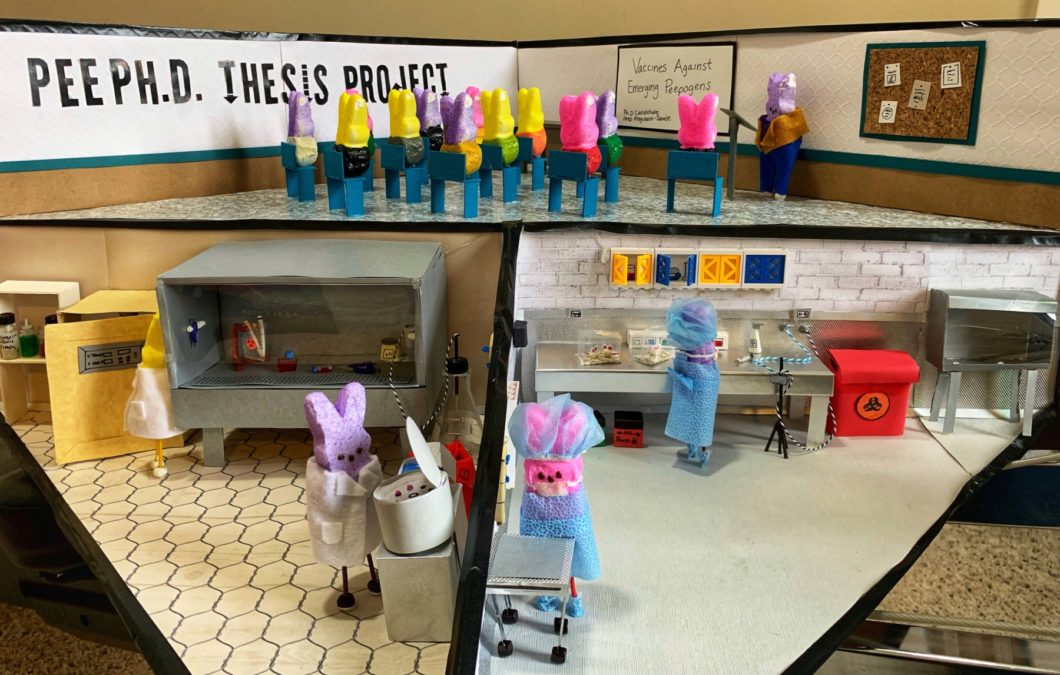
This diorama is an oversimplification of my training as a Peeph.D. student. My thesis project is about creating viral vaccines to target emerging peepogens (pathogens). This project encompasses vaccine engineering and production (scene 1), testing the vaccines in small animals (scene 2), and sharing and presenting my findings to different audiences (scene 3). Not shown are the daily struggle and dedication, the amount of research and learning, the constant troubleshooting, and the overnight experiments that are common in a graduate student’s life. I wanted to share part of what my life has looked like for the past 5 years so that people can understand that science is a multidimensional process. I also wanted an excuse to showcase the blending of art and science through visual communication. Of note, the diorama lights up and many of the supplies used for this project are upcycled laboratory materials. Enjoy! [See the full entry at TON‘s Peeps gallery.] Stephanie Anguiano-Zarate
What the judges said: We appreciate the meticulous representation of specific scenes—three specific scenes! We love her close attention to detail, which rewards close viewing; her use of lab materials; her careful construction; and her excellent representation of several aspects of a graduate student’s life in science.
Crafter:
Stephanie Anguiano-Zarate, Ph.D. student at the Mayo Clinic Graduate School of Biomedical Sciences, Rochester, Minnesota.
What inspired you to make this diorama?
My fond love of miniatures and my interest in the intersection between science and art. I am also an aspiring science communicator and this was an excellent opportunity to showcase my Ph.D. research.
What did you find the most fun about crafting with Peeps? Most challenging?
The most fun was painting all the Peeople (scene 3) who are attending my presentation about my thesis project. I also love the fact that Peeps are made in different colors, which can represent diversity. As a member of an underrepresented community in STEM, it was a great opportunity to showcase that anyone, regardless of what race, identity, and defining characteristics, can be a scientist. The most challenging was making near-accurate laboratory clothes that fit the Peeps.
What advice do you have for others who want to make peep dioramas?
They are loads of fun but do require dedication. It’s all in the details! Think outside the box!
Is there anything else people should know about you or your diorama?
A large portion of the supplies used to make my diorama was recycled and included repurposed laboratory supplies. The small biohazard waste bag inside the biosafety cabinet in scene 1 was made from a cookie bag (Yes, I had snacks during the 52 hours, spread over one week, it took to create this, LOL). Both biosafety cabinets light up; the one in scene 2 lights up a blue/purple color to simulate UV light for hood disinfection. The legs of the rolling, grey cart in scene 2 are made from blood lancets and the mice in that scene are made from tiny craft pompoms. I also used surgical mask face shields to make the mouse cages (scene 2), the tissue culture flasks (scene 1), and the windows of the biosafety cabinets. This has been one of the most entertaining projects I’ve ever worked on!
Silver Peep (Teens) and Peeple’s Choice Award:
Peepiodic Table of the Elements
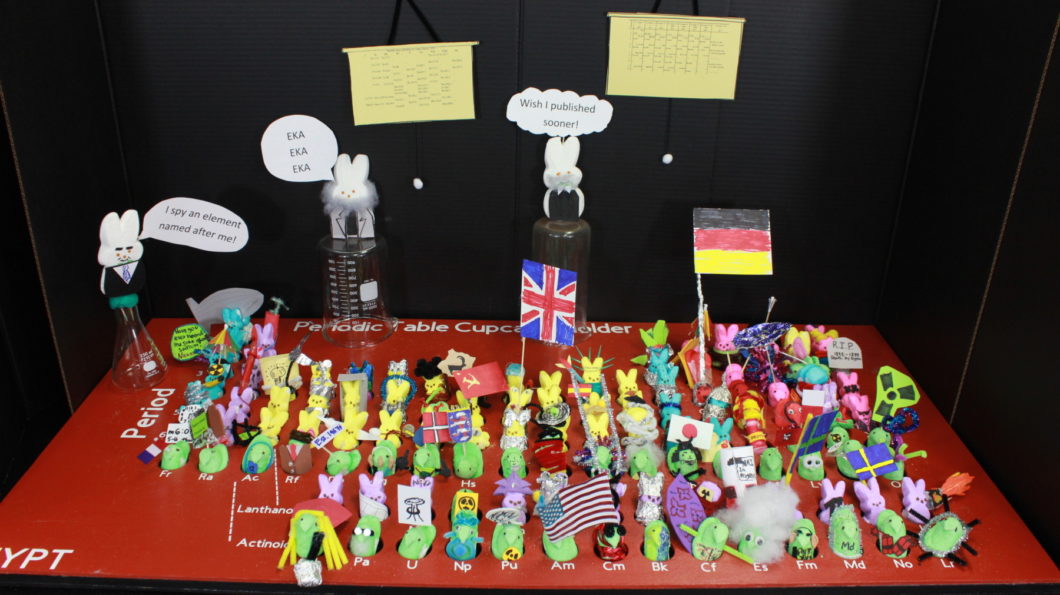
This is the International Year of the Periodic Table #IYPT2019 to celebrate the 150th birthday of the periodic table. The Peeps are decorated and color-coded to denote the different types of elements. The 7 diatomic elements contain 2 Peeps stuck together. The 3 big bunny scientists are Glenn Seaborg – “I spy an element named after me” (Seaborgium #106) (the rule was: You can’t name an element after someone living and then they did); Dmitri Mendeleev – “Eka, Eka, Eka” (He is considered the father of the periodic table because he predicted the properties of 3 elements); and Lothar Meyer – “Wish I published sooner” (No one seems to know him although he discovered the periodic table around the same time as Dmitri) to help students understand the history surrounding this icon. My favorite Peep is Bismuth an element found in Pepto Bismol. [See the full entry at TON‘s Peeps gallery.] Sally Mitchell, Rye High ChemClub Members, Mrs. Mitchell's Chemistry Classes
What the judges said: We were overwhelmed by this exuberant interpretation of the periodic table, with more jokes and puns than can be relayed in the entry form. We appreciated the thoughtful use of a variety of Peep sizes and colors, and that the project was scientifically accurate and highly collaborative.
Crafters:
Sally Mitchell, Rye High School chemistry teacher in Rye, New York; 74 chemistry students and ChemClub members. Mentored by Mary Virginia Orna, professor of chemistry at the College of New Rochelle.
What inspired you to make this diorama?
Mitchell: I was inspired to do this diorama because it is the International Year of the Periodic Table #IYPT2019, and this was a great way to involve my students in this international celebration. (Editors’ note: Read more about this project here.)
What did you find the most fun about crafting with Peeps? Most challenging?
The most fun we had crafting with the Peeps was allowing high school students to be creative again. They had fun researching their element, decorating it and then writing about their inspiration. As the day progressed, students came back after school to see the finished product.
The most challenging part of the project was finding all of the different colors of Peeps. I was able to find every color and flavor in my hometown of Syracuse, New York. I made two road trips to get more Peeps.
What advice do you have for others who want to make peep dioramas?
My advice to others: Involve others in the project. Share ideas and the diorama will have lasting memories.
Is there anything else people should know about you or your diorama?
You can see patterns in the periodic table through our Peeps. Give it a look. We are planning to do much more with our Peepiodic table—watch for us on YouTube.
Silver Peep (Kids):
Pure Wild Peep
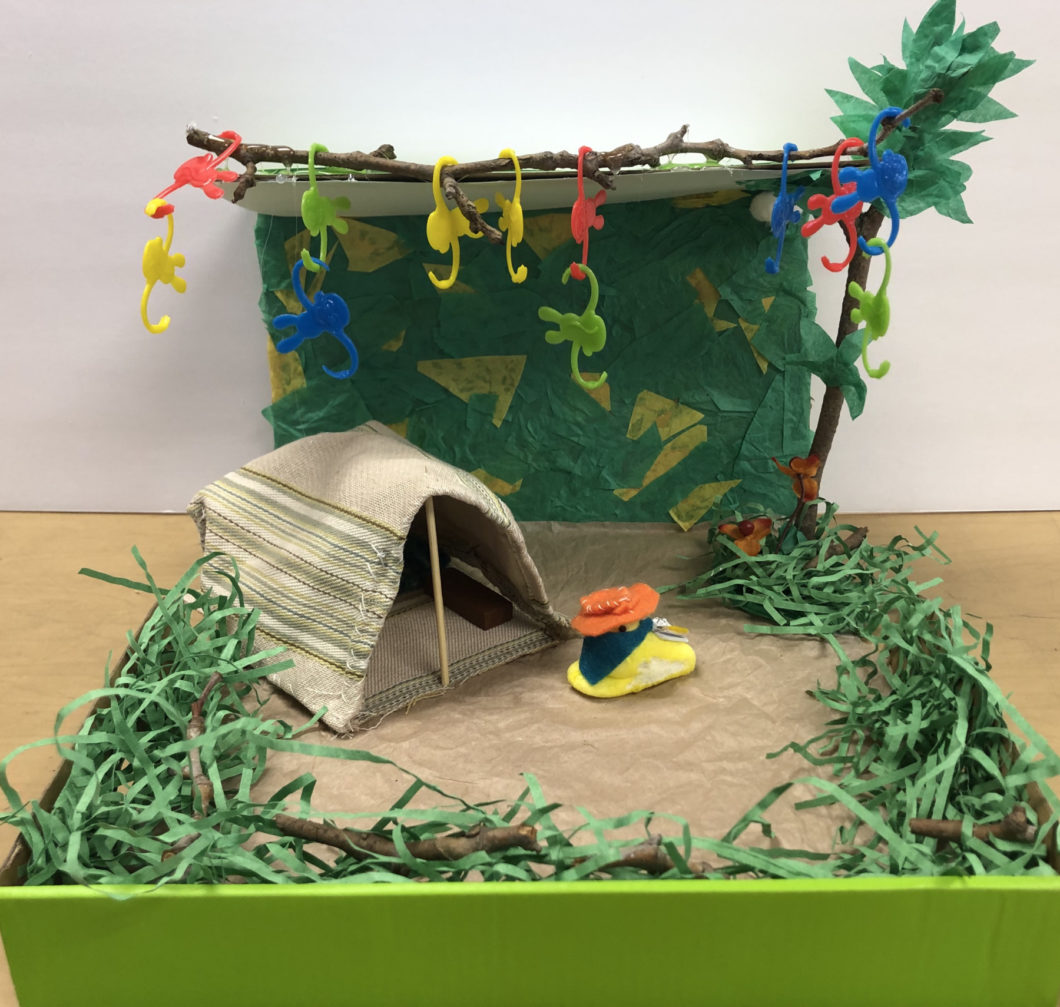
Jane Goodall ventures deep into the forest to research chimpanzees. This diorama was made by Lucy Higgenbotham, a 6th grader in Mrs. Natalie Tamblyn’s 5th/6th grade class in Sacramento, California. Students in this class made Peeps dioramas about scientists who they chose to profile, and also wrote essays about their chosen scientists. 14 students submitted dioramas to the 2019 contest. [See the full entry at TON‘s Peeps gallery.] Lucy Higgenbotham

What the judges said: The carefully made diorama represented its own unique aesthetic. It is evocative, making us think about a particular place and time. We love the use of the Barrel of Monkeys and the attention to detail—look at Jane’s notebook and pencil!
Crafter:
Lucy Higgenbotham, Sacramento, California, elementary school student in 6th grade.
What inspired you to make this diorama?
Well, my class did the Peeps project as an assignment. I chose to do mine on Jane Goodall because I thought the environment would be a little different from what other people were doing. Also Jane Goodall is one of my favorite scientists, and I have always been really inspired by her work. (Editors’ note: Read more about this diorama and Mrs. Tamblyn’s class project here.)
What was the most fun thing about crafting with Peeps? Most challenging?
What I liked most about crafting with the Peeps is being able to do almost anything you want with them. There weren’t many requirements on what needed to be in your diorama, which made it unique and more enjoyable than your average school project. The most challenging thing for me was getting my diorama to stand. It is displayed in a shoe box and I didn’t really want to have closed-in sides and have to work in the tight corners, so cutting them off made it difficult. However, I was able to make a tree with a twig to hold the box up!
What advice do you have for others who want to make peep dioramas?
My advice for someone who would want to do this project is to make it your own, and not to feel like you need to follow any guidelines or compare yourself to what someone else is doing. Also have fun with it, (and don’t eat too many Peeps!)
Is there anything else people should know about you or your diorama?
Well, I did make a lot of the objects/accessories featured in my diorama. The only store-bought things in it were the monkeys, the flower, and the grass. (And the Peep of course.) I sewed the tent and made the hat, bandana, and notebook with the pencil for my Peep. I really enjoyed doing the project, and I hope that other people will want to try it.
Most Accurate Representation of Science:
New Hare-izons: Ultima Peep Flyby

Peep scientists are investigating an unusual object at the far reaches of the solar system, known as Ultima Peep. The spacecraft New Hare-rizons is closing in, and images of Ultima Peep are becoming clearer. At first, Ultima Peep appeared to be shaped like a bowling pin, but now, some are beginning to suspect that Ultima Peep is shaped like a peep. (Perhaps it is a lonely space peep?) The peeple demand information! Scientists have called a press conference to weigh in, and journalists are peepering them with questions. The scientific inspiration for this diorama is, of course, NASA’s New Horizons spacecraft and its investigation of the Kuiper Belt object Ultima Thule, the shape of which became clearer as the spacecraft got closer. Unfortunately, in our world, bunny ears never materialized. The diorama also includes a title and a close-up of the encounter between New Hare-rizons and Ultima Peep. [See the full entry at TON‘s Peeps gallery.] Emily Conover
What the judges said: Those of us who have attended NASA press conferences loved the accuracy and details, from the layout of the room to the reporter who isn’t paying attention. Comparing Ultima Thule’s shape to a Peep makes perfect sense. We appreciated the liberal use of Peeps puns and the un-science meme on the satellite illustration. We also thought the title and explanatory cards were really nicely done.
Crafter:
Emily Conover, Washington, DC, physics reporter for Science News magazine.
What inspired you to make this diorama?
I’d been following the updates as NASA’s New Horizons spacecraft got closer and closer to the distant Kuiper Belt object, Ultima Thule. As its shape became clearer, it went from blob, to bowling pin, to snowman. I realized it was only one step away from being Peep-shaped: It just needed ears! So I imagined a world in which the Peeps were studying this object and speculating about whether it was actually the shape of a Peep. Since I’m a journalist, I decided to make the setting a press conference with Peep reporters.
What did you find the most fun about crafting with Peeps? Most challenging?
I had never made a Peep diorama before but I may be addicted now. I had so much fun making their clothes and tiny objects for them to hold. It’s capeeptivating to see them come alive as you start adding little details. The most challenging part was that most peeple did not share my newfound passion for Peep dioramas, and I had to supeepress my desire to talk about it all the time.
What advice do you have for others who want to make Peep dioramas?
Just keep pecking away at it! And a practical suggestion: Take them out of the box the day before you want to work with them, because they are easier to work with when stale. For example, you can use a nail file to shave down stale Peeps’ butts to make a flat surface so they will stand up well.
Is there anything else people should know about you or your diorama?
I had Peep-related dreams throughout the process of creating this.
Best Use of Peeps:
Museum of Natural Peepstory
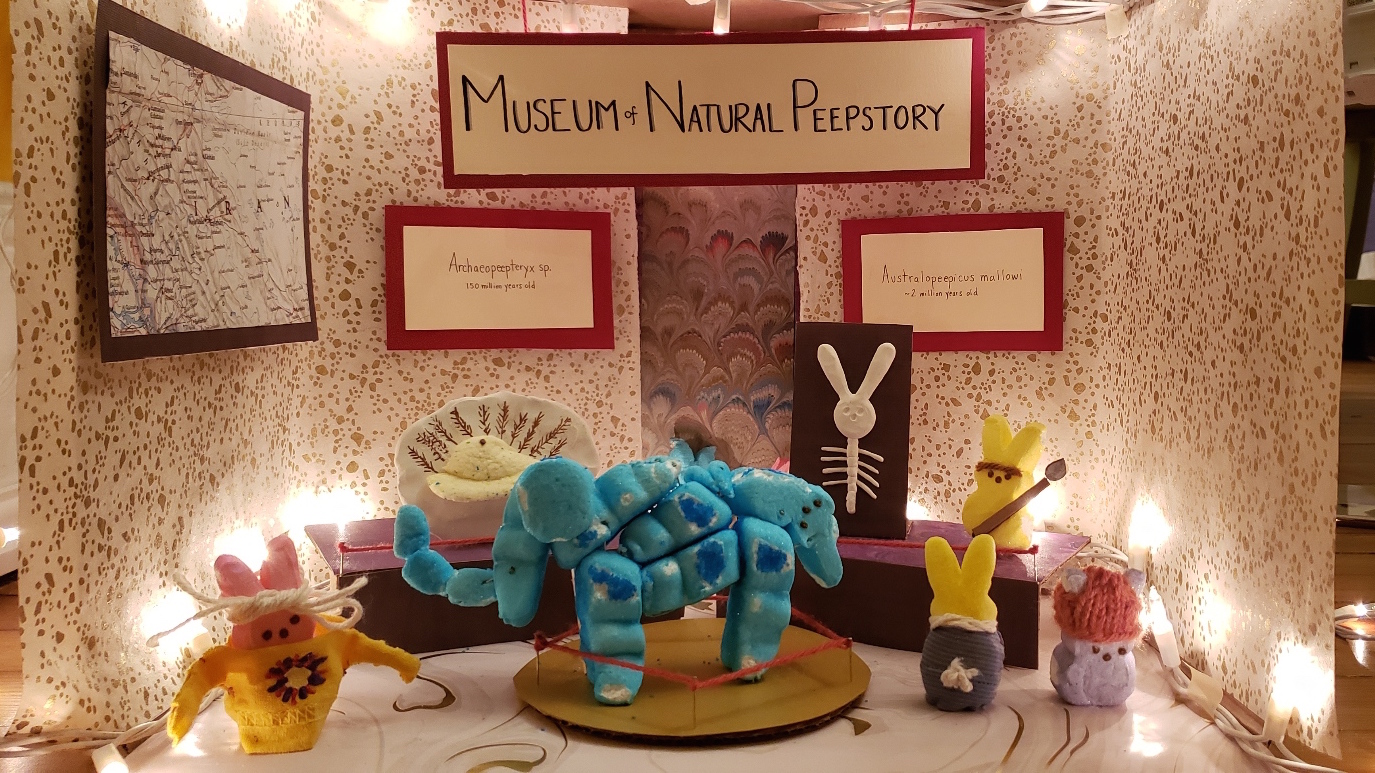
This year, the Peeps are taking a visit to their favorite Washington, DC destination: the Museum of Natural Peepstory. See the peeps learning about their past as they gaze at the 150-million-year-old fossil of Archaeopeepteryx, proving their ancient relatives once had feathers even though they no longer posses such magnificent plumage. They also examine the skeleton and cultural past of their more recent ancestor, Australopeepicus mallowi. Of course no visit to the MNP is complete without a stop at the stunning taxidermied centerpiece … the Peepephant. [See the full entry at TON‘s Peeps gallery.] Anna Rothschild, Shaena Montanari, Sarah Kaplan, Maryam Zaringhalam, Kate Furby
What the judges said: We loved the many ways the team used Peeps: as both museum visitors and museum displays. Turning Peep pieces into an elephant was a stroke of genius. The construction, costuming, and attention to detail were all wonderful. One judge noted how clever it was to include an anthropological diorama within a diorama.
Crafters:
Shaena Montanari, AAAS Science and Technology Policy Fellow; Maryam Zaringhalam, AAAS Science and Technology Policy Fellow; Kate Furby, science writer/producer; Anna Rothschild, host of Anna’s Science Magic Show at The Washington Post; Sarah Kaplan, reporter at The Washington Post. All crafters are from Washington, DC.
What inspired you to make this diorama?
We are all big museum fans so it was sort of a no-brainer. Also Shaena is a paleontologist and really wanted to somehow incorporate a Peep “fossil.”
What did you find the most fun about crafting with Peeps? Most challenging?
Most challenging was cutting up Peeps and rearranging them into the giant Peepephant. Kate gets most of the credit for this incredible creation. The most fun part was collaborating with friends. We had an absolute blast doing this together. Watching everyone create tiny Peep fashions (mainly Anna knitting a hat and Maryam sewing silly clothing) was pretty hilarious. Sarah staged the scene perfectly and also made amazing brownies for us while we were constructing the diorama.
What advice do you have for others who want to make Peep dioramas?
Definitely do it, because crafting with friends is the most fun.
Is there anything else people should know about you or your diorama?
It was a true group effort and we couldn’t have created something so magnificent without this special team!
Best Science History:
Dmitri Mendelpeep Dreams Up
an Early Version of the Peepriodic Table
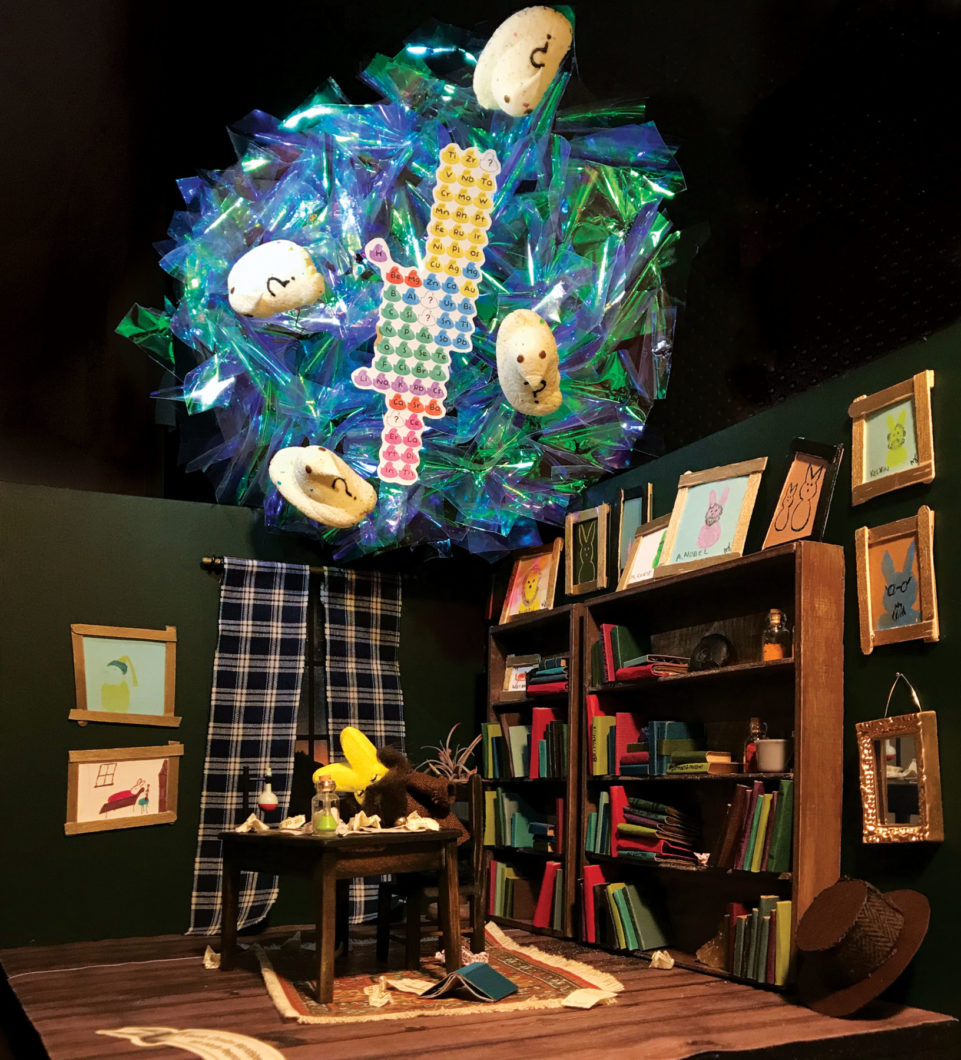
To celebrate 2019 as the International Year of the Peepriodic Table, Chemical & Engineering News naturally created a diorama made of Peeps. According to historic documents, the peepriodic table came to Dmitri Mendelpeep in a dream. “I saw in a dream a table where all the elements fell into place as required. Awakening, I immediately wrote it down on a piece of peeper,” he recounted. What made Mendelpeep’s ordering of the elements stand out from the arrangements other chempeeps had dreamed up was that his peepriodic table left spaces for elements that hadn’t yet been discovered. [See the full entry at TON‘s Peeps gallery.] Kerri Jansen, Yang Ku, Craig Bettenhausen, Melissa Gilden, Tiên Nguyễn, Linda Wang, Lauren Wolf, Amanda Yarnell; Brainstormers: Laura Howes, Sam Lemonick, Jessica Marshall, Jessica Morrison
What the judges said: This diorama creatively represents a moment in history. We love the use of the question mark Peeps to illustrate Mendelpeep’s room-to-grow version of the periodic table. We were delighted with the team’s attention to detail—many of the items in the diorama were hand-made. We liked how carefully the periodic table was made, even though it was tiny.
Crafters:
Kerri Jansen, a multimedia reporter with Chemical & Engineering News, and Yang Ku, an art director with C&EN, were the project leads. And we had about a dozen C&EN staff members helping out at various levels with this project, from brainstorming to construction. A few of the remote staff in California and Germany even called in to help brainstorm. The diorama was constructed in Washington, DC.
What inspired you to make this diorama?
We’ve all had periodic table on the brain lately because 2019 is the International Year of the Periodic Table. The question was which moment to depict from the entire history of the periodic table and all of its 118 elements? I have this book called Mendeleyev’s Dream: The Quest for the Elements that ends on the image of an exhausted chemist falling asleep in the middle of his work, moments from finally unraveling the order of the elements. I’m not sure how much artistic license was involved with that description, but we were charmed regardless, and we picked that dreamy moment for our diorama.
What did you find the most fun about crafting with Peeps? Most challenging?
I loved the slow reveal of my colleagues’ hidden crafting skills. Now I know whom to go to for help building tiny furniture, or who is strangely good at making little drawings of Peep bunnies that look like famous historical chemists. The most challenging was filling the bookshelves with all of those tiny books, which was a multi-day effort. There are 100 in all. Every one was made by hand, at first lovingly and then with gradually increasing levels of lamentation and despair. Also, we could not find a glue that stuck well to the Peep. If any of the other Peep crafters out there know this secret, please share it with us.
What advice do you have for others who want to make Peep dioramas?
Order twice as many pizzas as you think you will need for the crafting party.
Is there anything else people should know about you or your diorama?
This was truly a group effort. Every single person involved contributed something unique. I want to extend special recognition to Yang Ku, who spearheaded the “dreamscape” portion of the diorama and built those miniature bookshelves in her office with a Dremel rotary tool.
Honorable Mention Certificates
Best Use of Material Collected in the Field: Icelandic Volcanopeep
What the judges said: The material’s incorporation added nicely to the scene’s dramatic aesthetic.
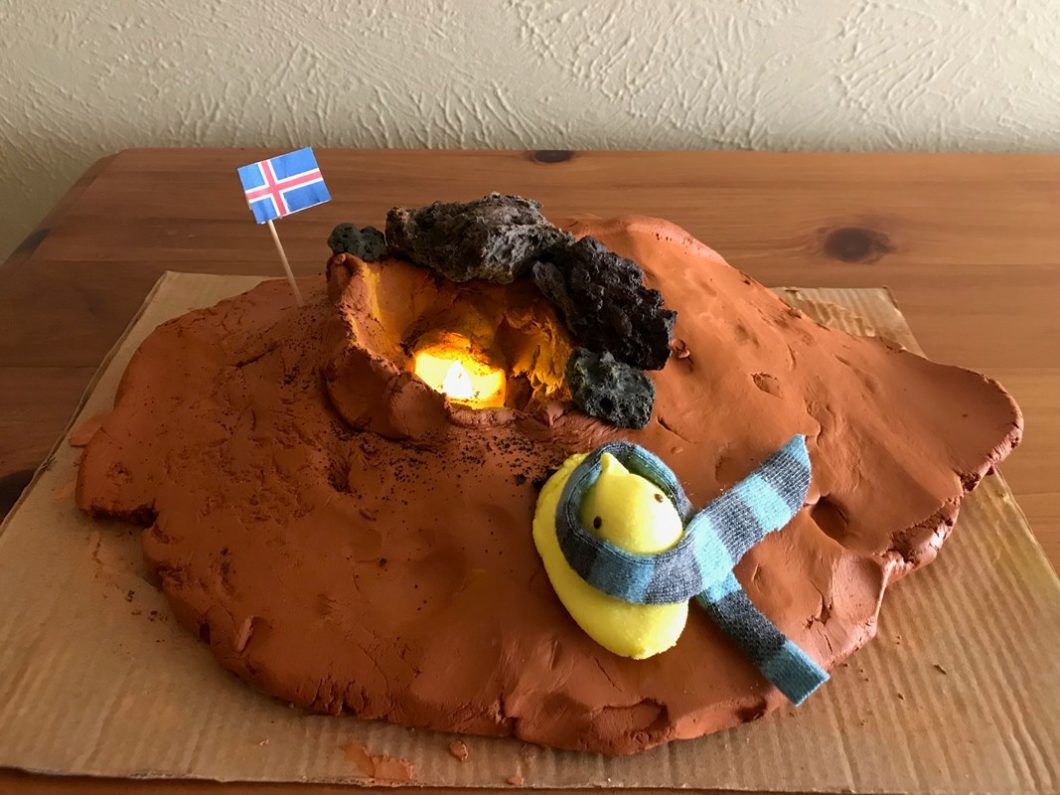
Youngest Participant: Peep at the Moon
What the judges said: We were delighted at this young man’s enterprise in choosing to enter the contest; his crafting choices—in particular, the Lego vehicle and the marshmallow helmets—are signs of great dioramas to come.
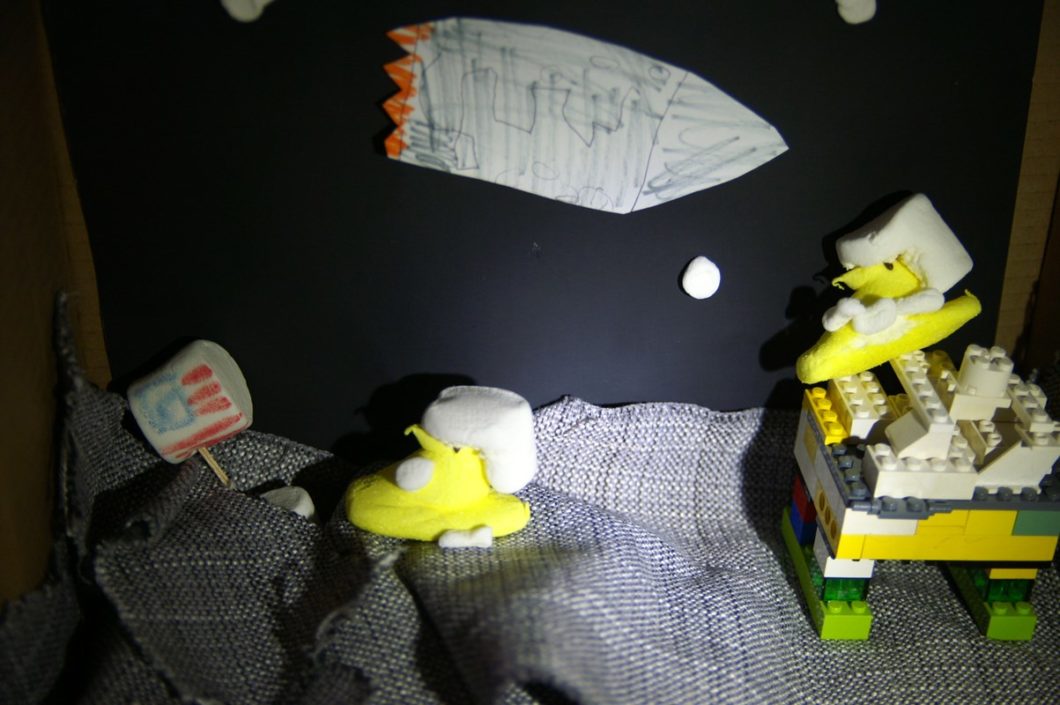
Best Social Action Theme: Pluto Protest
What the judges said: We enjoyed this social history-take on a recent scientific debate. (Editors’ note: Read more about this diorama and Mrs. Tamblyn’s class project here.)
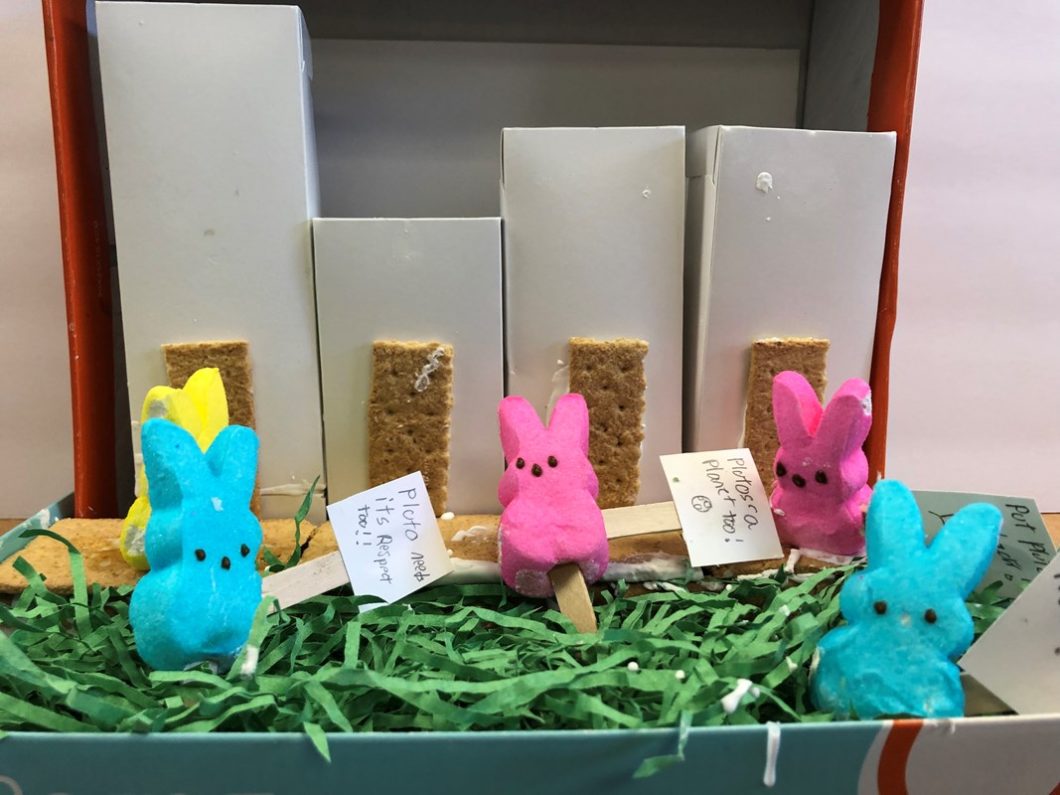
Best Depiction of Climate Change: Snowshoe Hare Peepulation Research
What the judges said: Evocative use of different sized Peeps, and natural materials, to illustrate a broad scientific issue through a single moment in time. (Also, we liked the Wisconsin shout-outs.)

Best Thought Experiment: Schrödinger’s Peep
What the judges said: We’re still pondering this one. Is the Peep alive in that microwave at this particular moment?!?

Best Recreation of an Historical Figure: Peepola Tesla
What the judges said: This studious Peep was instantly recognizable as Tesla, even without the accurate representation of the rest of the famous photograph.

Best Use of Historical Details (costuming, setting): Computer Peeps and the Time Traveling AstroPeepicist
What the judges said: From Ada Lovelace’s headdress to Brian May’s scholarly cap and gown, from the jacquard loom cards to the telescope, this story is told—delightfully—through the details.
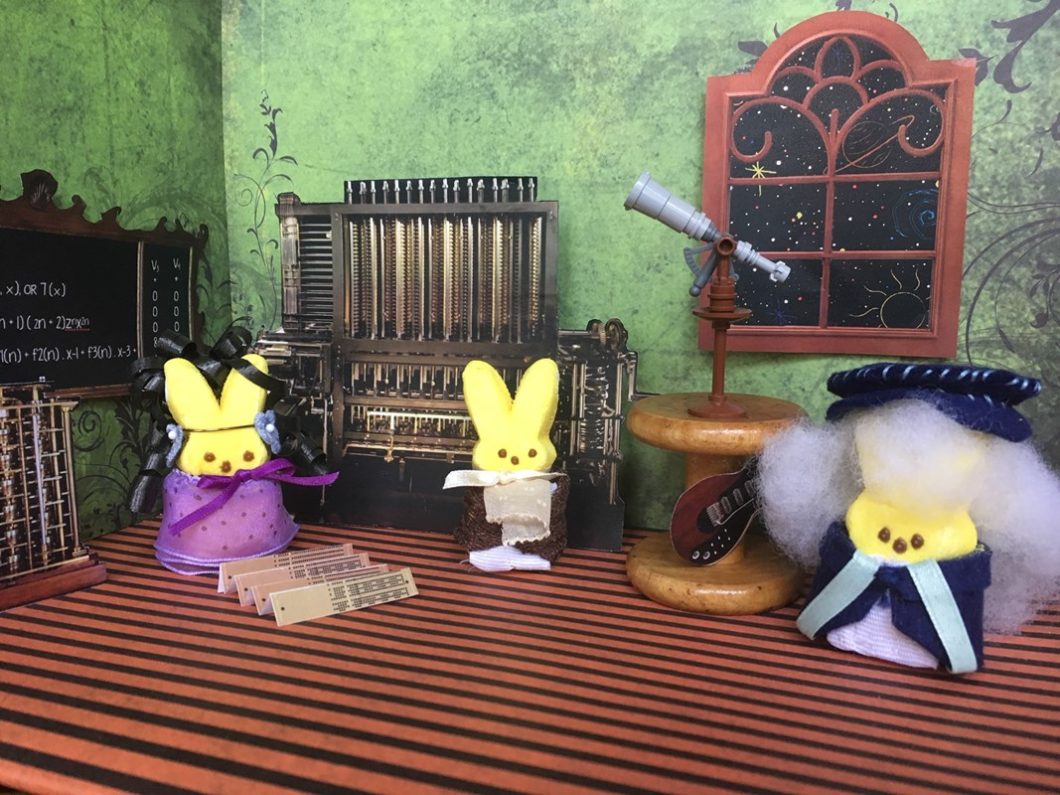
—Ada Byron Lovelace, a mathemapeeptian who wrote the first computer algorithm. She is seen with the jacquard loom punch cards that inspired her programming process, and chalkboard equations from her Notes on Menabrea’s Sketch of the Analytical Engine.
—Charles Babbage, a polypeep who invented the Difference Engine, a mechanical calculator designed to generate numeric tables based on Isaac Newton’s method of “divided differences,” as well as the much larger Analytical Engine, which was never fully assembled (in our universe, anyway).
—Brian May, an astropeepicist who studies the Zodiacal Dust Cloud, was a university chancellor, authored books about the cosmos and stereophotography, and played lead guitar for the popular rock band, Queen. Meg Evans Smith
Best Metaphor: Rice CRISPR/Peep9
What the judges said: We all agreed that this was a perfect way to explain a complicated scientific process—and entirely appropriate to the medium of marshmallow.

Best Adaptation of a Work of Art (a tie):
- Anatopeep Lesson: Dr. Nicopeep Tulp Demonstrating the Anatomy of the Ear
- First “Peep”eration with Ether
What the judges said: Both had perfect costuming, lighting, and arrangement (several judges particularly noted the evocative posing of the main characters in the “Peep”eration scene), entirely reminiscent of the paintings on which they were based.
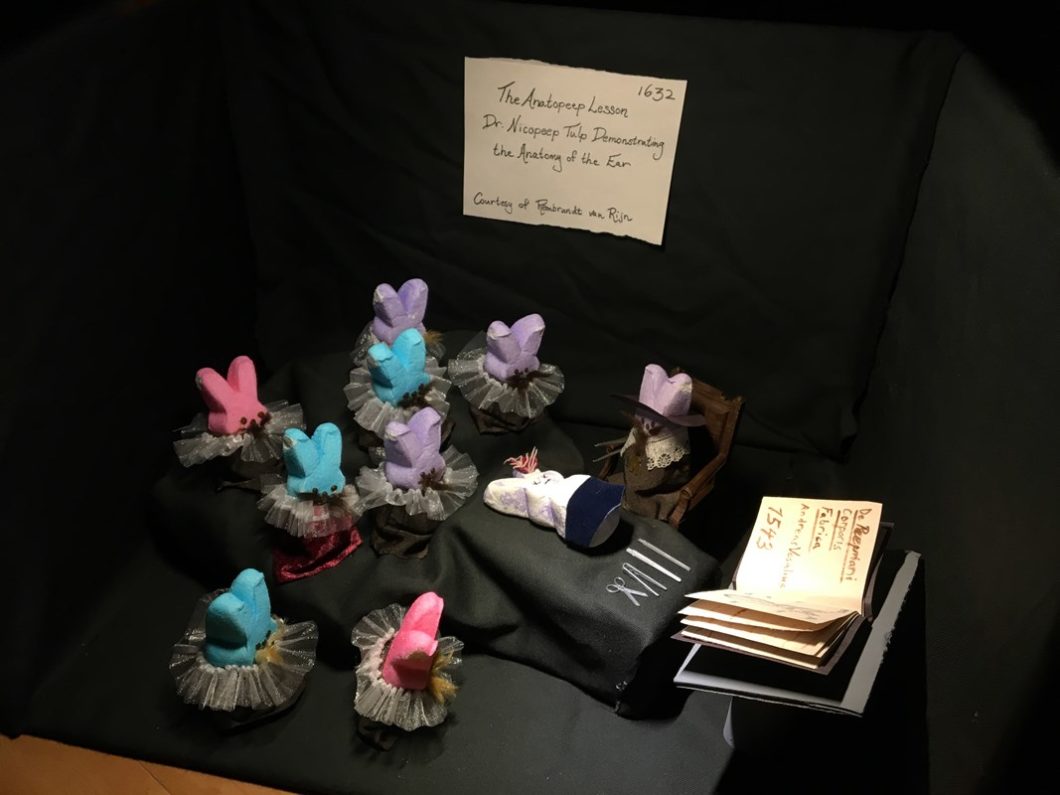
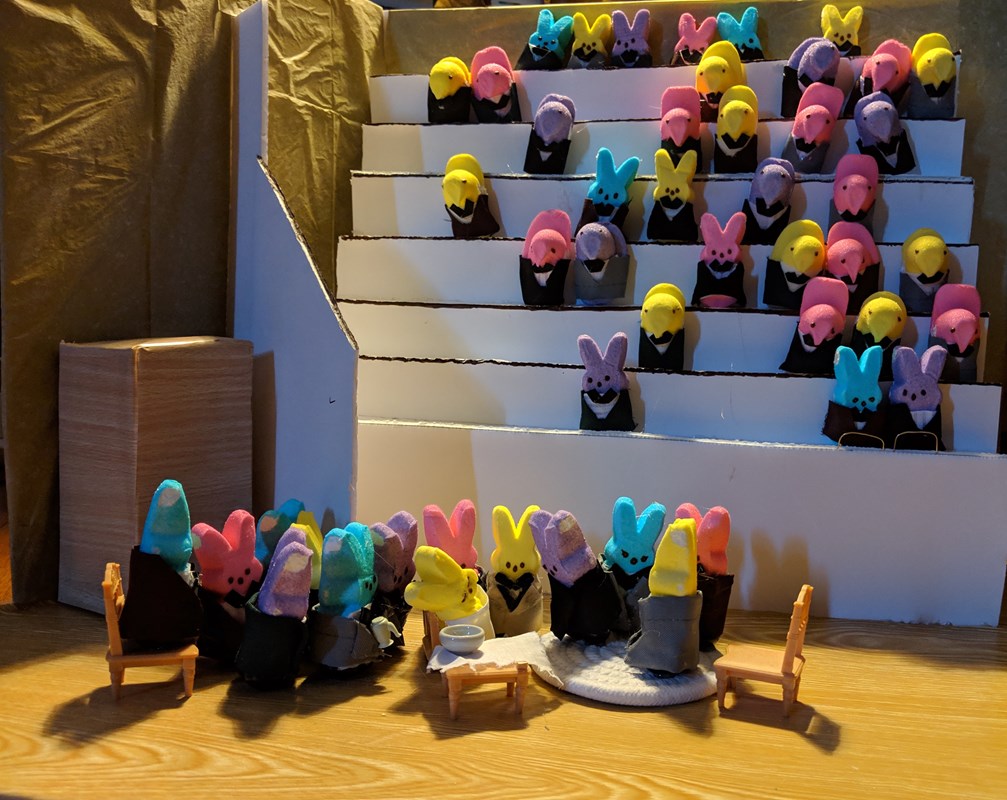
Best Entry Description: Peep-Printing and Pavlov’s Peeps: Pioneering Studies in Ethology and Behaviorism
What the judges said: It rhymed! And it told us what we were seeing!
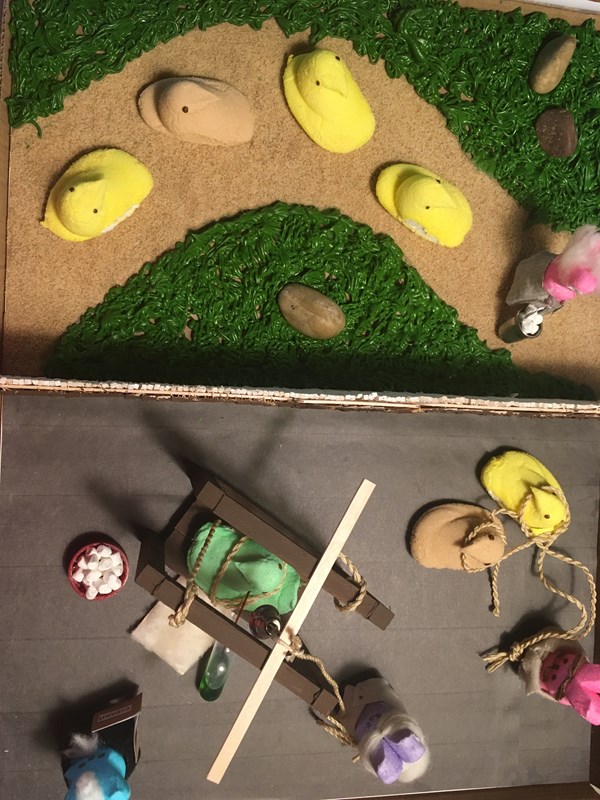
In a farmyard where animals freely go.
Peeplings follow neither mother geese nor hens,
But an Austrian gentleman named Konrad Lorenz.
Our second scene is of a Russian lab in the early teens:
An observation that with the ring of a bell,
Peeps’ physiology responded as well.
While modern ethicists may deem his methods cruel,
Pavlov remains known for his studies on drool.
(Konrad Lorenz’s scene is based on the famous photo of him being followed by greylag geese; Pavlov’s scene is inspired by the various photos of his lab. Mini marshmallows are Peep food!) Katie Ellis
Best Entry Photography: Neanderpeeps
What the judges said: The dramatically-lit photo through the peephole (ha!) was an excellent touch.
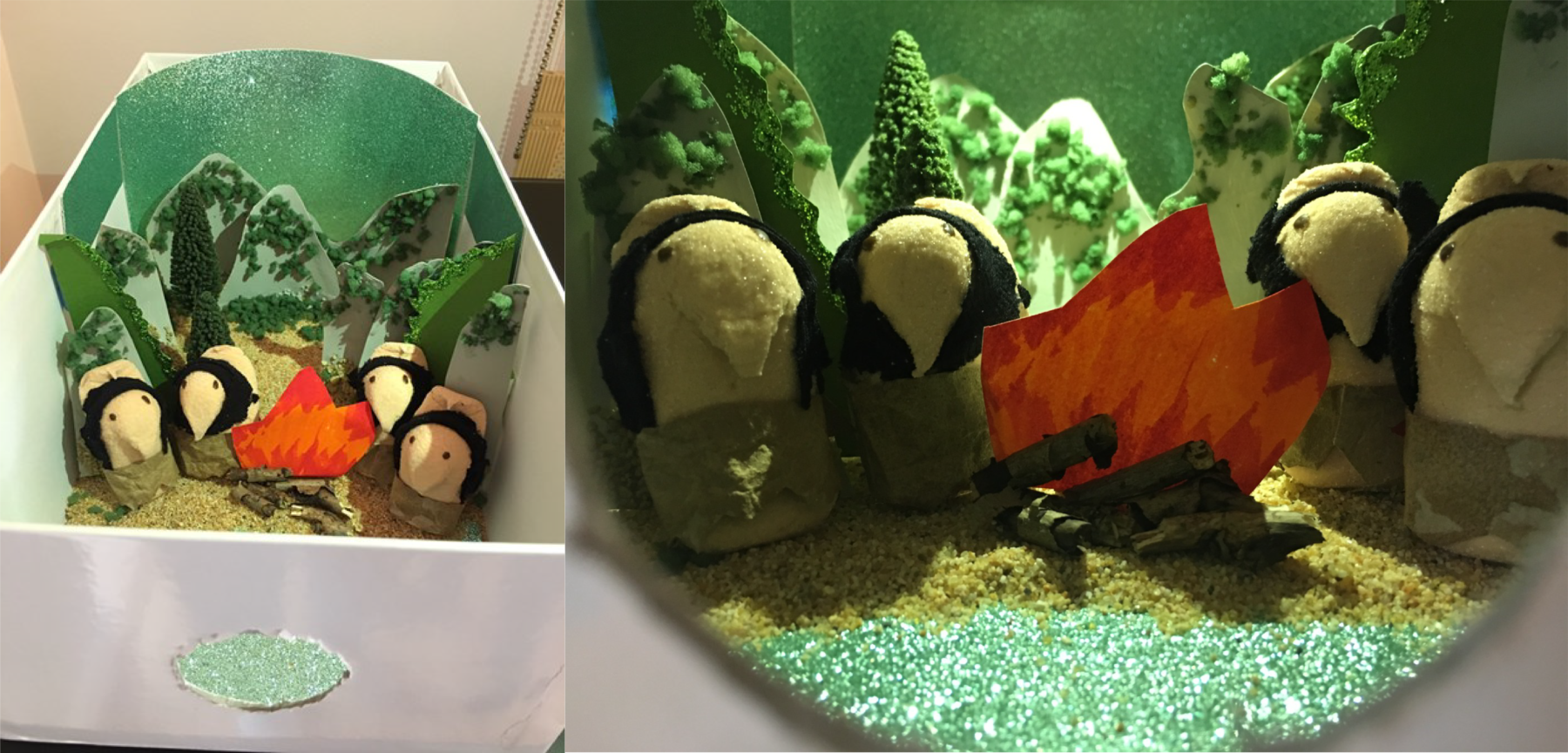
PLUS: A Special Judges’ Thank You Certificate
for Mrs. Tamblyn’s 5th/6th Grade Class
All the judges were so happy to see a group of kids engaged in science and science history, and we particularly appreciated the diversity of topics. We want to thank the students for participating in such an enthusiastic way, and we hope that they’ll continue to engage with science (and with the art of dioramas)!

